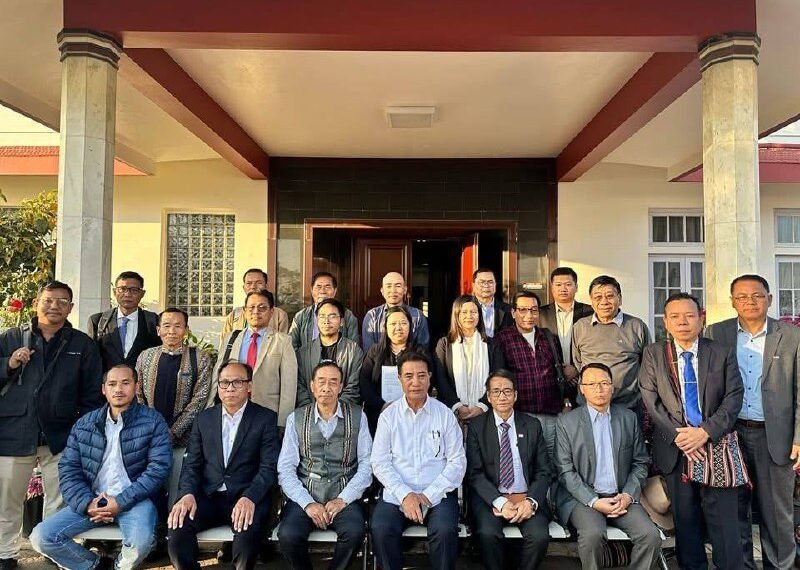Unity in the Fight for Freedom: The Chinland Council (CC) and the Interim Chin National Consultative Council (ICNCC) merge forces, resolving internal conflicts to strengthen their fight for an autonomous Chin state.
BY PC Bureau
In a significant development for Myanmar’s resistance movement, two major Chin rebel factions have agreed to merge and form a unified governing body, the Chin National Council (CNC).
The Chinland Council (CC) and the Interim Chin National Consultative Council (ICNCC) signed a unification agreement on Wednesday in Aizawl, Mizoram, following negotiations facilitated by Mizoram Chief Minister Pu Lalduhoma. The merger aims to strengthen the Chin resistance against Myanmar’s military regime and streamline governance efforts in Chin State.
Unification Amid Internal Divisions
The agreement comes after years of division between the two factions, which, despite a shared goal of opposing military rule, have operated independently. The Chinland Council, formed in December 2023 after breaking away from the ICNCC, is backed by the Chin National Front (CNF) and its armed wing, the Chin National Army (CNA). Meanwhile, the ICNCC, established in April 2021 following the military coup, commands the Chin Brotherhood, a resistance force that has been actively fighting junta troops.
ALSO READ: SENSATIONAL: Myanmar’s Junta Chief Tied to Cyber Scam Syndicates
Having two separate governing bodies for the Chin people was counterproductive, so we agreed to merge,” a joint statement from both groups read.
Building a Unified Front
The newly formed Chin National Council will oversee governance and resistance efforts in Chin State, where local armed groups have seized control of most territories from the junta. A constitution drafting committee has also been established to lay the groundwork for a future autonomous Chin administration.
Meanwhile, discussions are ongoing between the CNA and Chin Brotherhood to integrate their forces into a single military structure capable of defending Chinland from junta offensives.
Strategic and Regional Implications
The unification marks a major step in consolidating the Chin resistance movement and is expected to bolster military and political coordination against Myanmar’s military regime.
“This is an extremely encouraging and significant development,” said Tayzar San, a prominent pro-democracy activist in Myanmar. “If our revolutionary forces unite, I would say our revolution is [almost] complete.”
The merger also signals increased regional backing, with Mizoram’s government playing a key role in facilitating talks. The Zo Reunification Organisation (ZORO), an India-based civil society group advocating for Mizo ethnic unity, also assisted in mediation efforts.
ALSO READ: Manipur Governor must clear the air on Arambai Tenggol’s claim
Current Situation in Chin State
Despite resistance gains, Myanmar’s military still holds key locations, including Hakha, Thantlang, Tedim, and Falam. However, resistance forces control over 80 percent of Chin State, including thirteen townships and the Myanmar-India border town of Rihkhawdar.
One exception is Paletwa Township, which fell under the control of the Arakan Army (AA) in January 2024, complicating territorial claims in the region.
With a more unified resistance front, the Chin National Council is expected to push for greater territorial consolidation and seek international support in its fight against Myanmar’s military rule.
Significance of the Merger
The two rival ethnic Chin organizations decide to unite under the same banner.
The Chin Brotherhood Alliance (CB) and the Chinland Council (CC) merge to form the “Chin National Council.”
Source (Chinland Council): https://t.co/eGzLOOzGKQ pic.twitter.com/9fsNtkFsMm
— Asia Intel (@Asia_Intel) February 26, 2025
the agreement resolves long-standing divisions among Chin insurgents, which have previously weakened their collective efforts against the junta. By uniting under the CNC, the groups have agreed to establish a single administrative council, streamlining governance and military coordination. They have also formed a constitution drafting committee, integrating representatives from both factions to create a legal and political framework for a future autonomous Chin state.
Leaders urged all ‘Zohnahthlak’ (ethnic Mizo) communities in Chin state to support the merger, emphasizing its role in fostering unity, understanding, and lasting peace. The unification is seen as a critical move in strengthening resistance efforts while paving the way for political stability and self-determination.
A leader from a peace advocacy group that facilitated the talks expressed optimism, stating that the agreement could end internal rivalries, reduce bloodshed, and bring long-term stability among Chin rebel forces. Over the past two years, clashes between insurgent groups and Myanmar’s military have resulted in significant casualties, making this unification a potential turning point in the conflict.
The merger is expected to enhance the Chin resistance’s military strength, political legitimacy, and diplomatic standing, both within Myanmar and on the international stage.













